Lancia Ypsilon 2012 Owner handbook (in English)
Manufacturer: LANCIA, Model Year: 2012, Model line: Ypsilon, Model: Lancia Ypsilon 2012Pages: 307, PDF Size: 13.3 MB
Page 171 of 307
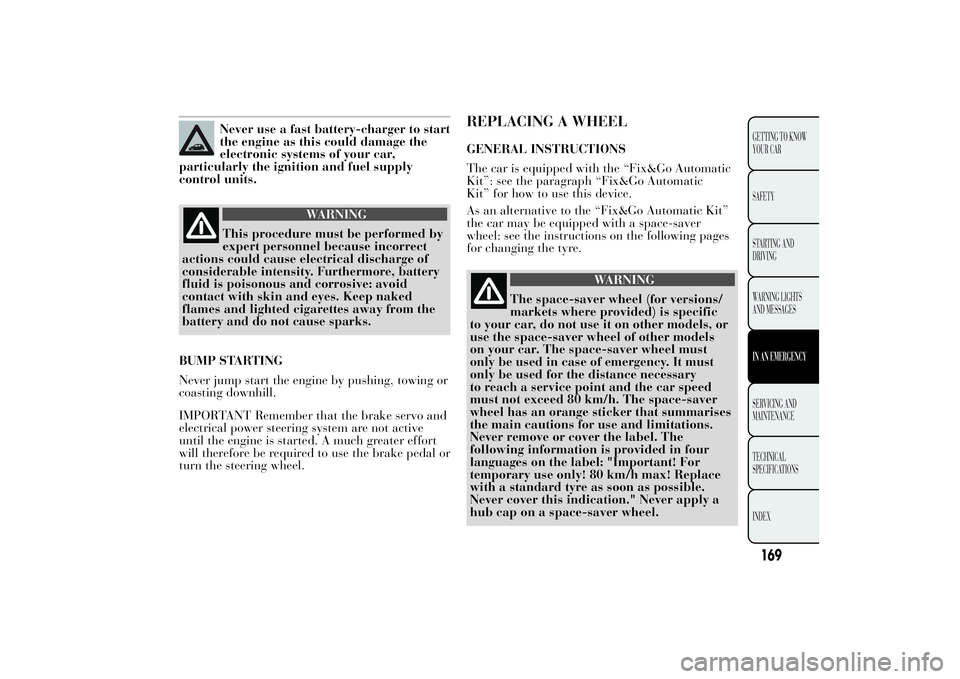
Never use a fast battery-charger to start
the engine as this could damage the
electronic systems of your car,
particularly the ignition and fuel supply
control units.
WARNING
This procedure must be performed by
expert personnel because incorrect
actions could cause electrical discharge of
considerable intensity. Furthermore, battery
fluid is poisonous and corrosive: avoid
contact with skin and eyes. Keep naked
flames and lighted cigarettes away from the
battery and do not cause sparks.
BUMP STARTING
Never jump start the engine by pushing, towing or
coasting downhill.
IMPORTANT Remember that the brake servo and
electrical power steering system are not active
until the engine is started. A much greater effort
will therefore be required to use the brake pedal or
turn the steering wheel.
REPLACING A WHEELGENERAL INSTRUCTIONS
The car is equipped with the “Fix&Go Automatic
Kit”: see the paragraph “Fix&Go Automatic
Kit” for how to use this device.
As an alternative to the “Fix&Go Automatic Kit”
the car may be equipped with a space-saver
wheel: see the instructions on the following pages
for changing the tyre.
WARNING
The space-saver wheel (for versions/
markets where provided) is specific
to your car, do not use it on other models, or
use the space-saver wheel of other models
on your car. The space-saver wheel must
only be used in case of emergency. It must
only be used for the distance necessary
to reach a service point and the car speed
must not exceed 80 km/h. The space-saver
wheel has an orange sticker that summarises
the main cautions for use and limitations.
Never remove or cover the label. The
following information is provided in four
languages on the label: "Important! For
temporary use only! 80 km/h max! Replace
with a standard tyre as soon as possible.
Never cover this indication." Never apply a
hub cap on a space-saver wheel.
169GETTING TO KNOW
YOUR CAR
SAFETY
STARTING AND
DRIVING
WARNING LIGHTS
AND MESSAGESIN AN EMERGENCYSERVICING AND
MAINTENANCE
TECHNICAL
SPECIFICATIONS
INDEX
Page 172 of 307
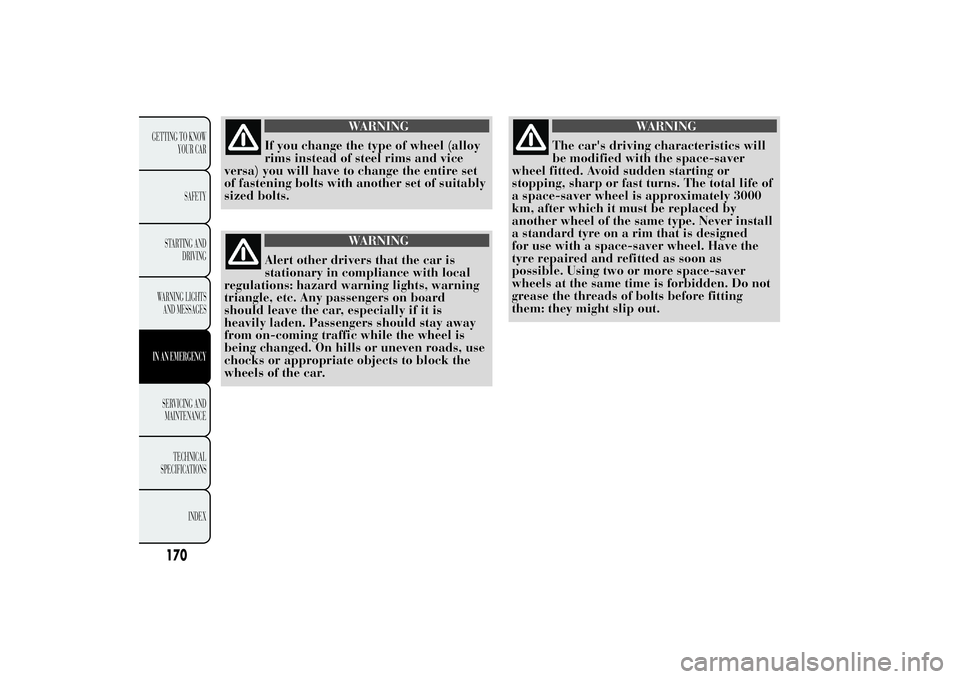
WARNING
If you change the type of wheel (alloy
rims instead of steel rims and vice
versa) you will have to change the entire set
of fastening bolts with another set of suitably
sized bolts.
WARNING
Alert other drivers that the car is
stationary in compliance with local
regulations: hazard warning lights, warning
triangle, etc. Any passengers on board
should leave the car, especially if it is
heavily laden. Passengers should stay away
from on-coming traffic while the wheel is
being changed. On hills or uneven roads, use
chocks or appropriate objects to block the
wheels of the car.
WARNING
The car's driving characteristics will
be modified with the space-saver
wheel fitted. Avoid sudden starting or
stopping, sharp or fast turns. The total life of
a space-saver wheel is approximately 3000
km, after which it must be replaced by
another wheel of the same type. Never install
a standard tyre on a rim that is designed
for use with a space-saver wheel. Have the
tyre repaired and refitted as soon as
possible. Using two or more space-saver
wheels at the same time is forbidden. Do not
grease the threads of bolts before fitting
them: they might slip out.
170
GETTING TO KNOW
YOUR CAR
SAFETY
STARTING AND
DRIVING
WARNING LIGHTS
AND MESSAGESIN AN EMERGENCYSERVICING AND
MAINTENANCE
TECHNICAL
SPECIFICATIONS
INDEX
Page 173 of 307
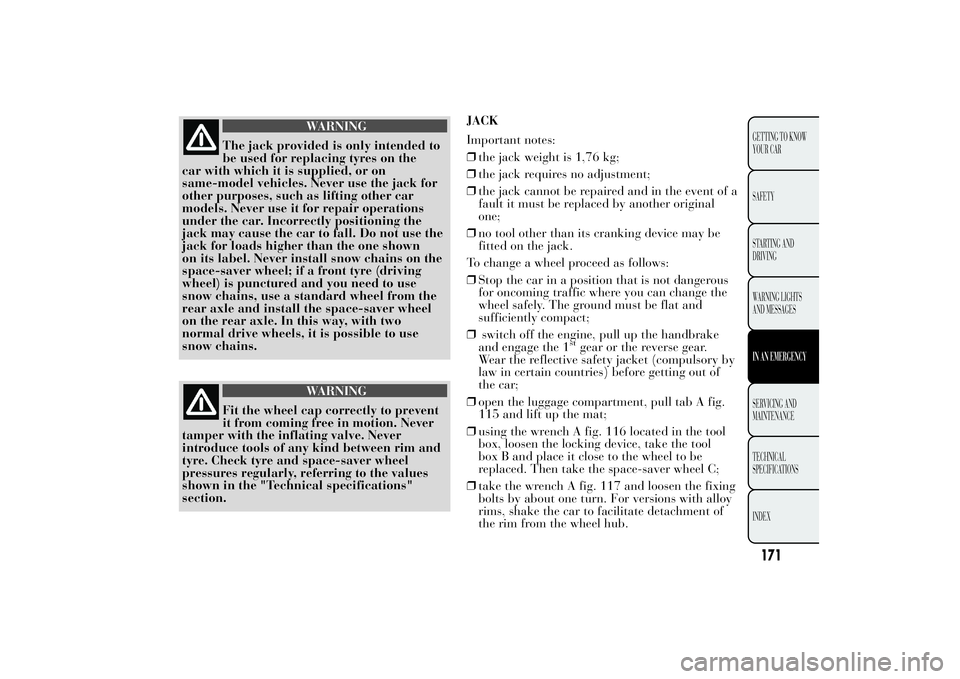
WARNING
The jack provided is only intended to
be used for replacing tyres on the
car with which it is supplied, or on
same-model vehicles. Never use the jack for
other purposes, such as lifting other car
models. Never use it for repair operations
under the car. Incorrectly positioning the
jack may cause the car to fall. Do not use the
jack for loads higher than the one shown
on its label. Never install snow chains on the
space-saver wheel; if a front tyre (driving
wheel) is punctured and you need to use
snow chains, use a standard wheel from the
rear axle and install the space-saver wheel
on the rear axle. In this way, with two
normal drive wheels, it is possible to use
snow chains.
WARNING
Fit the wheel cap correctly to prevent
it from coming free in motion. Never
tamper with the inflating valve. Never
introduce tools of any kind between rim and
tyre. Check tyre and space-saver wheel
pressures regularly, referring to the values
shown in the "Technical specifications"
section.JACK
Important notes:
❒the jack weight is 1,76 kg;
❒the jack requires no adjustment;
❒the jack cannot be repaired and in the event of a
fault it must be replaced by another original
one;
❒no tool other than its cranking device may be
fitted on the jack.
To change a wheel proceed as follows:
❒Stop the car in a position that is not dangerous
for oncoming traffic where you can change the
wheel safely. The ground must be flat and
sufficiently compact;
❒switch off the engine, pull up the handbrake
and engage the 1
stgear or the reverse gear.
Wear the reflective safety jacket (compulsory by
law in certain countries) before getting out of
the car;
❒open the luggage compartment, pull tab A fig.
115 and lift up the mat;
❒using the wrench A fig. 116 located in the tool
box, loosen the locking device, take the tool
box B and place it close to the wheel to be
replaced. Then take the space-saver wheel C;
❒take the wrench A fig. 117 and loosen the fixing
bolts by about one turn. For versions with alloy
rims, shake the car to facilitate detachment of
the rim from the wheel hub.
171GETTING TO KNOW
YOUR CAR
SAFETY
STARTING AND
DRIVING
WARNING LIGHTS
AND MESSAGESIN AN EMERGENCYSERVICING AND
MAINTENANCE
TECHNICAL
SPECIFICATIONS
INDEX
Page 174 of 307
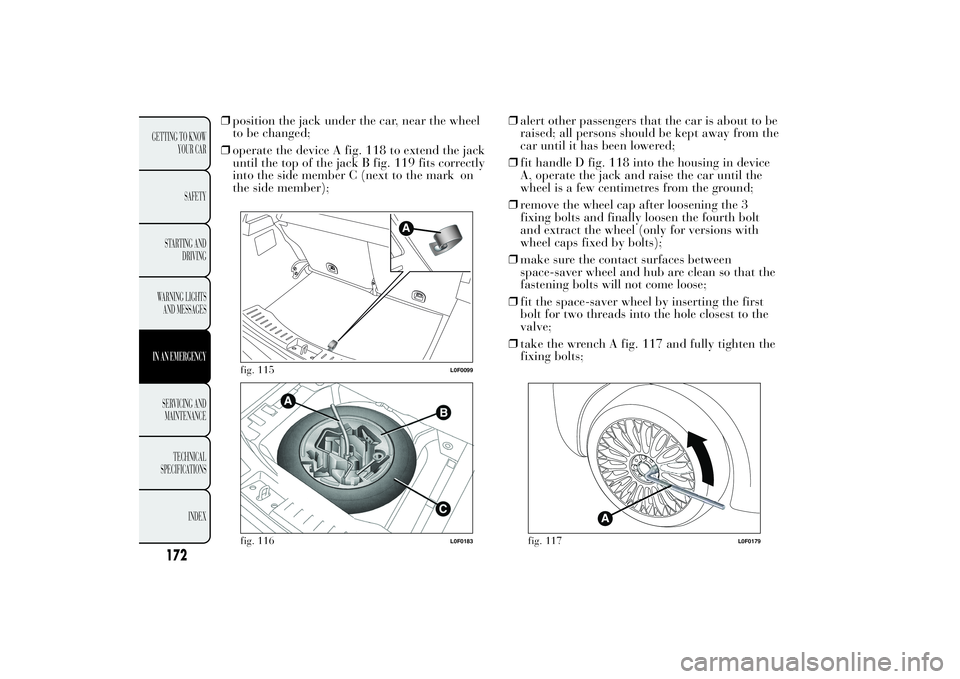
❒position the jack under the car, near the wheel
to be changed;
❒operate the device A fig. 118 to extend the jack
until the top of the jack B fig. 119 fits correctly
into the side member C (next to the mark on
the side member);❒alert other passengers that the car is about to be
raised; all persons should be kept away from the
car until it has been lowered;
❒fit handle D fig. 118 into the housing in device
A, operate the jack and raise the car until the
wheel is a few centimetres from the ground;
❒remove the wheel cap after loosening the 3
fixing bolts and finally loosen the fourth bolt
and extract the wheel (only for versions with
wheel caps fixed by bolts);
❒make sure the contact surfaces between
space-saver wheel and hub are clean so that the
fastening bolts will not come loose;
❒fit the space-saver wheel by inserting the first
bolt for two threads into the hole closest to the
valve;
❒take the wrench A fig. 117 and fully tighten the
fixing bolts;
fig. 115
L0F0099
fig. 116
L0F0183
fig. 117
L0F0179
172
GETTING TO KNOW
YOUR CAR
SAFETY
STARTING AND
DRIVING
WARNING LIGHTS
AND MESSAGESIN AN EMERGENCYSERVICING AND
MAINTENANCE
TECHNICAL
SPECIFICATIONS
INDEX
Page 175 of 307
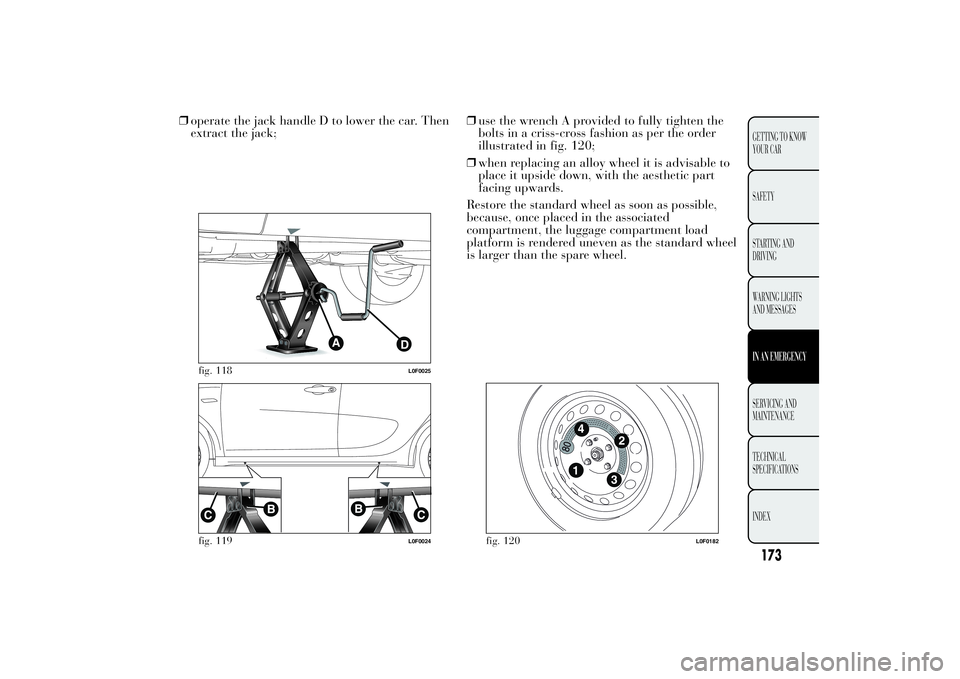
❒operate the jack handle D to lower the car. Then
extract the jack;❒use the wrench A provided to fully tighten the
bolts in a criss-cross fashion as per the order
illustrated in fig. 120;
❒when replacing an alloy wheel it is advisable to
place it upside down, with the aesthetic part
facing upwards.
Restore the standard wheel as soon as possible,
because, once placed in the associated
compartment, the luggage compartment load
platform is rendered uneven as the standard wheel
is larger than the spare wheel.
fig. 118
L0F0025
fig. 119
L0F0024
fig. 120
L0F0182
173GETTING TO KNOW
YOUR CAR
SAFETY
STARTING AND
DRIVING
WARNING LIGHTS
AND MESSAGESIN AN EMERGENCYSERVICING AND
MAINTENANCE
TECHNICAL
SPECIFICATIONS
INDEX
Page 176 of 307
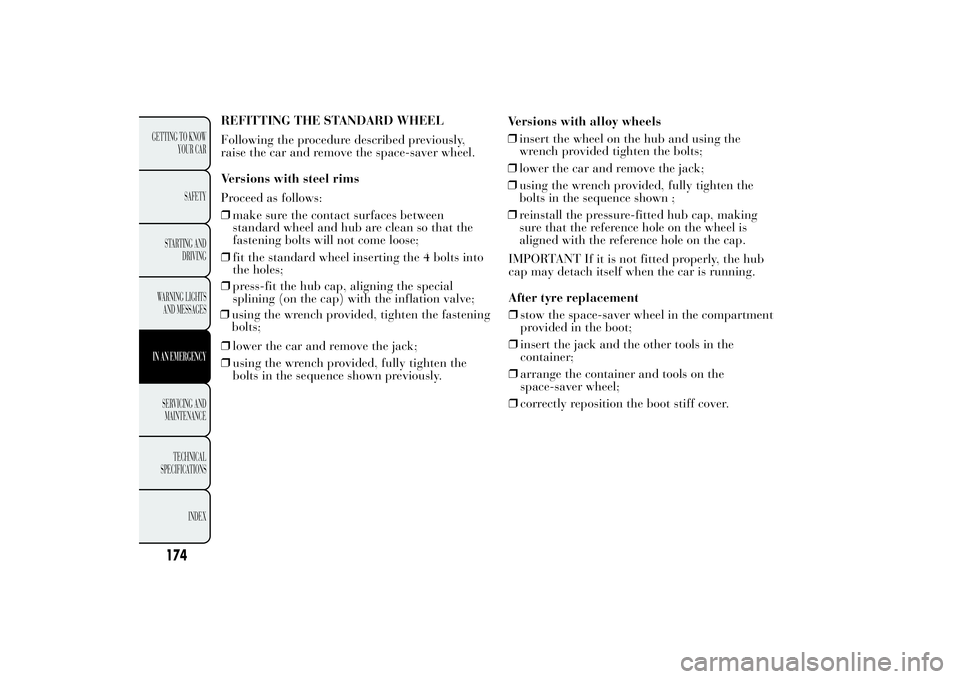
REFITTING THE STANDARD WHEEL
Following the procedure described previously,
raise the car and remove the space-saver wheel.
Versions with steel rims
Proceed as follows:
❒make sure the contact surfaces between
standard wheel and hub are clean so that the
fastening bolts will not come loose;
❒fit the standard wheel inserting the 4 bolts into
the holes;
❒using the wrench provided, tighten the fastening
bolts; ❒press-fit the hub cap, aligning the special
splining (on the cap) with the inflation valve;
❒lower the car and remove the jack;
❒using the wrench provided, fully tighten the
bolts in the sequence shown previously.Versions with alloy wheels
❒insert the wheel on the hub and using the
wrench provided tighten the bolts;
❒lower the car and remove the jack;
❒using the wrench provided, fully tighten the
bolts in the sequence shown ;
❒reinstall the pressure-fitted hub cap, making
sure that the reference hole on the wheel is
aligned with the reference hole on the cap.
IMPORTANT If it is not fitted properly, the hub
cap may detach itself when the car is running.
After tyre replacement
❒stow the space-saver wheel in the compartment
provided in the boot;
❒insert the jack and the other tools in the
container;
❒arrange the container and tools on the
space-saver wheel;
❒correctly reposition the boot stiff cover.
174
GETTING TO KNOW
YOUR CAR
SAFETY
STARTING AND
DRIVING
WARNING LIGHTS
AND MESSAGESIN AN EMERGENCYSERVICING AND
MAINTENANCE
TECHNICAL
SPECIFICATIONS
INDEX
Page 177 of 307

"Fix&Go Automatic" kitIt is located in a special container in the luggage
compartment fig. 121. The container also contains
a screwdriver and the tow hook.
The kit fig. 122 contains:
❒a bottle A fig. 122 containing sealer and fitted
with:
❒filling pipe B;
❒sticker C bearing the notice “max. 80 km/h”, to
be placed in a position visible to the driver (on
the instrument panel) after fixing the tyre;
❒a compressor D including a pressure gauge and
connections, found in the compartment;❒instruction brochure (see fig. 123), to be used
for prompt and correct use of the tyre quick
repair kit and then to be handed to the
personnel charged with handling the treated
tyre;
❒a pair of protective gloves located in the side
compartment of the compressor;
❒adapters for inflating different elements.
WARNING
Give the instructions brochure to the
technicians who will be handling
the tyre that was repaired using the tyre
quick repair kit.
fig. 121
L0F0093
fig. 122
L0F0006
175GETTING TO KNOW
YOUR CAR
SAFETY
STARTING AND
DRIVING
WARNING LIGHTS
AND MESSAGESIN AN EMERGENCYSERVICING AND
MAINTENANCE
TECHNICAL
SPECIFICATIONS
INDEX
Page 178 of 307
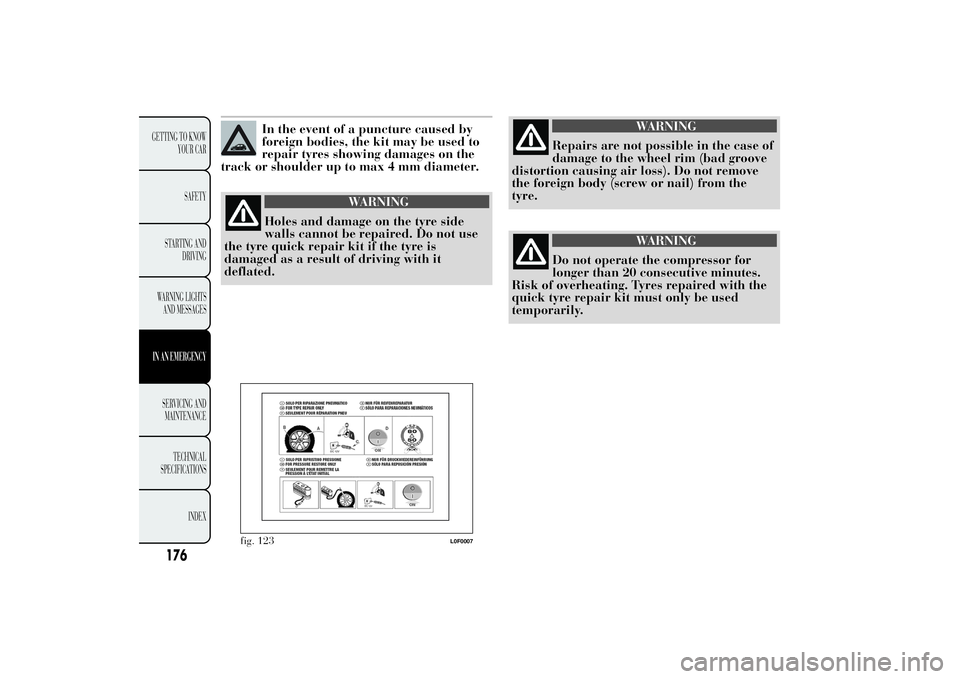
In the event of a puncture caused by
foreign bodies, the kit may be used to
repair tyres showing damages on the
track or shoulder up to max 4 mm diameter.
WARNING
Holes and damage on the tyre side
walls cannot be repaired. Do not use
the tyre quick repair kit if the tyre is
damaged as a result of driving with it
deflated.
WARNING
Repairs are not possible in the case of
damage to the wheel rim (bad groove
distortion causing air loss). Do not remove
the foreign body (screw or nail) from the
tyre.
WARNING
Do not operate the compressor for
longer than 20 consecutive minutes.
Risk of overheating. Tyres repaired with the
quick tyre repair kit must only be used
temporarily.
fig. 123
L0F0007
176
GETTING TO KNOW
YOUR CAR
SAFETY
STARTING AND
DRIVING
WARNING LIGHTS
AND MESSAGESIN AN EMERGENCYSERVICING AND
MAINTENANCE
TECHNICAL
SPECIFICATIONS
INDEX
Page 179 of 307

WARNING
The cylinder contains ethyl glycol.
Contains latex: may cause an allergic
reaction. Harmful if swallowed. Eye irritant.
May cause irritation if inhaled or on contact.
Avoid contact with eyes, skin and clothes.
In the event of contact, wash immediately
with plenty of water. If ingested, do not
induce vomiting. Rinse out your mouth,
drink large quantities of water and seek
immediate medical attention. Keep away
from children. The product must not be used
by asthmatics. Do not inhale the vapours
during insertion and suction. Call a doctor
immediately if allergic reactions are noted.
Store the canister in its proper
compartment, away from sources of heat.
The sealant fluid has an expiry date.
Replace the bottle containing out-of-date
sealant fluid.Dispose of the bottle and the sealant
liquid properly. Have the sealing fluid
and the cylinder disposed of in
compliance with national and local
regulations.INFLATING PROCEDURE
WARNING
Put on the protective gloves provided
together with quick tyre repair kit.
Proceed as follows:
❒Pull up the handbrake.Unscrew the tyre
valve cap, take out the flexible filler pipe A fig.
124 and tighten the ring nut B on the tyre valve;
❒make sure that the compressor switch A fig. 125
is in position 0 (off), start the engine, plug into
the power socket in the central tunnel fig. 126
and operate the compressor, turning switch A to
position I (on). Inflate the tyre to the pressure
specified in the "Inflation pressure" paragraph
in the "Technical specifications" section. Check
fig. 124
L0F0176
177GETTING TO KNOW
YOUR CAR
SAFETY
STARTING AND
DRIVING
WARNING LIGHTS
AND MESSAGESIN AN EMERGENCYSERVICING AND
MAINTENANCE
TECHNICAL
SPECIFICATIONS
INDEX
Page 180 of 307

tyre pressure on gauge B fig. 125 with
compressor off to obtain a more precise reading;
❒if after five minutes it is still impossible to reach
at least 1.8 bar, disengage the compressor from
the valve and power socket, then move the
car forwards by approx. ten metres in order to
distribute the sealing fluid inside the tyre evenly,then repeat the inflation operation;
❒if after this operation you still cannot reach at
least 1.8 bar after 5 minutes from switching
on the compressor, do not resume driving but
contact a Lancia Dealership;
WARNING
Apply the adhesive label where it can
be easily seen by the driver as a
reminder that the tyre has been treated with
the tyre quick repair kit. Drive carefully,
particularly on bends. Do not exceed 80
km/h. Do not accelerate or brake suddenly.
❒after driving for about 10 minutes stop and
check the tyre pressure again;pull up the
handbrake;For the safety of the car when it is
parked, follow the indication in the paragraph
"When parked" in the chapter "Starting up and
driving" .
WARNING
If the pressure has fallen below 1.8
bar, do not drive any further: the
automatic tyre quick repair kit cannot
guarantee the correct hold because the tyre
is too damaged. Contact a Lancia
Dealership.
fig. 125
L0F0181
fig. 126
L0F0178
178
GETTING TO KNOW
YOUR CAR
SAFETY
STARTING AND
DRIVING
WARNING LIGHTS
AND MESSAGESIN AN EMERGENCYSERVICING AND
MAINTENANCE
TECHNICAL
SPECIFICATIONS
INDEX